Which toilet is better than porcelain or earthenware or how
Each person, undertaking a major overhaul in plumbing premises, is faced with the problem of choosing suitable plumbing fixtures. Most disputes arise when resolving the question of what is best for a toilet bowl: faience or porcelain?
It is difficult to give an unequivocal answer, but the instruction presented below will help you understand all the technical nuances and make the right choice.
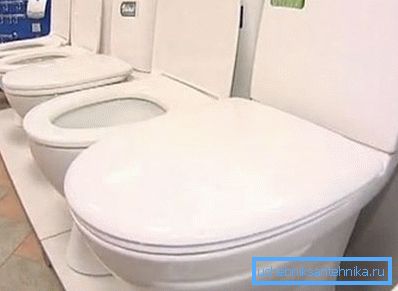
Criterias of choice
Before going to a specialized construction supermarket and choosing a porcelain or faience toilet there, it will be useful to decide on the main criteria that you should pay attention to when buying a particular model:
- The base of the toilet should be easily connected to the sewage system installed in your apartment or house. For example, a toilet with a vertical outlet will not be able to dock with the neck of the drain pipe mounted in the wall.
- The geometrical dimensions of the sanitary appliance should be chosen so that it is convenient to use, and it most organically fit into the interior of your toilet room.
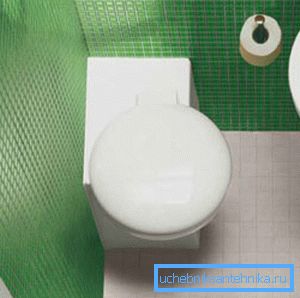
- If you buy a toilet or porcelain toilets complete with a cistern, pay attention to the ease of installing them by hand.
- The appearance of the product should correspond to the general style of the room.. However, the decorative component should not be put at the forefront. Take care and ergonomics of use.
- Regardless of whether you prefer a toilet — porcelain or earthenware — you will choose a bowl shape so that when you drain it, the water will spray less.
Features of modern models
Materials used
Modern industry produces a huge number of various plumbing fixtures. The most popular materials used for this are listed in the table.

| Material | Special features |
| Glass | Toilets made of glass have an attractive appearance, but require very careful maintenance. The slightest divorce or traces of dried spray from the water will make a discord in the refined interior of your toilet room. |
| Stainless steel | This material has a high strength and is easily cleaned from dirt. Thanks to these qualities, stainless steel appliances are most often installed in public places. The big drawback of the models described is the high price and too utilitarian appearance. |
| Polymer concrete (artificial stone) | Luxury toilets. Their cost is quite high, but it is fully justified by its exquisite appearance and the most unexpected forms. On sale are very rare and are made, as a rule, for individual orders. |
| A natural stone | Very, very expensive models that are produced in single versions. They look elegant and luxurious, but the surface of the stone is very sensitive to detergents containing acids. |
| Sanitary Ware | This category includes porcelain and earthenware products. The porcelain toilet bowl has a smoother and more beautiful surface, the faience one is cheaper, it withstands the effects of acids and alkalis, but is destroyed by excessive physical impact. |
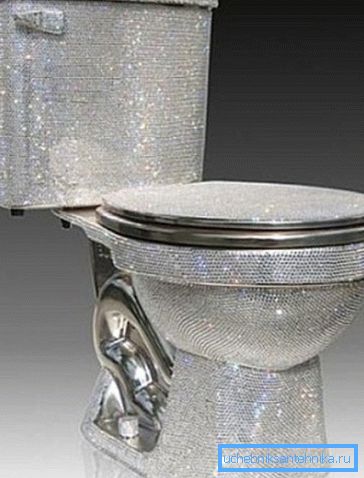
The most widely used products made of sanitary ceramics. Their technical characteristics and consumer properties will be discussed below.
Faience
For the manufacture of such toilet bowls white clay is used, so they have a dense, finely porous structure. Because of this, the product is characterized by a higher water absorption coefficient as for a sanitary appliance (this figure is 0.5%). To avoid soaking the device with water, its surface is covered with a layer of special glaze.
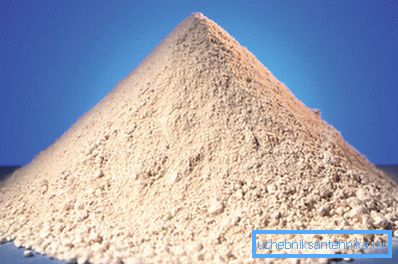
This layer protects the toilet from the penetration of water and gives the product an attractive appearance.
The advantages of using glaze for decoration of toilet bowls are obvious:
- provides the desired level of moisture resistance;
- gives the subject an attractive appearance that persists for a long time;
- does not change color and shine from the effects of negative external factors.
Earthenware appliances have thin walls. This is done deliberately, so as not to give the toilet too massive appearance. But the special processing methods and the glaze layer ensure reliability, which is enough for everyday use.
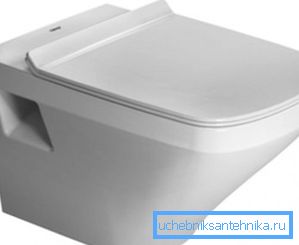
The advantage of faience is also in its cheapness. As a rule, toilets made of this material cost much less than similar products made of porcelain.
Note! There are exceptions to this rule. It all depends on the model, manufacturing plant and the country where the device is made. For example, earthenware products of a well-known foreign company can cost higher than domestic porcelain toilet bowls.
Porcelain
To make such a toilet, you need to add quartz and feldspar to the extracted white clay. Thanks to these two elements, the water absorption coefficient of the finished product is reduced by an order of magnitude and is 0.05%. In addition, the technical characteristics are much higher.

Toilets made of porcelain have the following advantages:
- thanks to the ultra-smooth, dense surface, it absorbs dirt and unpleasant odors worse, which is important for the toilet room;
- due to the homogeneous structure of the porcelain is easier to clean the dirt, to preserve its appearance you need to put much less effort;
- over time, the surface of the toilet does not form a yellow bloom from constant contact with water and biological waste;
- the material in question is stronger in comparison with faience.
Note! The last statement is also conditional. If you are hanging shelves in the toilet, drop a punch on the porcelain toilet, you will hardly notice the difference in the strength characteristics of both models.
Both earthenware and porcelain toilet bowls are covered with special glaze, due to which it is very problematic to distinguish these models from the outside. If you are in doubt about the choice, contact your dealer for assistance.

In addition, try to buy models treated with special compounds that prevent the accumulation of dirt on the surface of the plumbing device. This will help you to increase the service life of the product and shorten the time for washing it.
Product operation
Acquired toilet can long please you with its attractive appearance. But in order that its surface always remains white, you need to know how to clean a porcelain toilet or faience.
There are several popular ways.
The choice of a particular depends on the nature of the pollution:
- Spots that have been formed recently are well removed with vinegar (regular table or apple). To do this, you need to warm it up (without boiling), pour it into the toilet and leave it until morning.
- Mineral deposits can be disposed of with citric acid. Two - three sachets are poured into the bowl for several hours, after which the surface is cleaned with an ordinary brush.
- The most powerful tool is bleach.. It is able to clean even the oldest spots. Remember that this liquid (powder) is dangerous, so when using it, do not forget to wear gloves and a gauze bandage.

Conclusion
Knowing all the advantages and disadvantages of certain models, you can more intelligently approach the purchase of a toilet for arranging your own toilet room. But in order to use it safely, the device should be correctly mounted (see also the article Small Toilet - details of arranging a small restroom).
In more detail and clearly about this topic - in the video in this article.